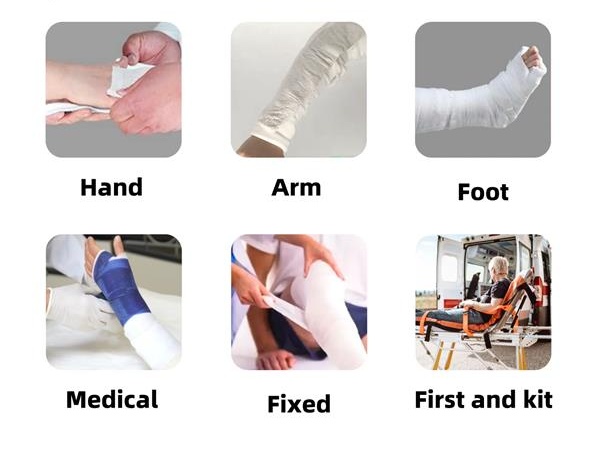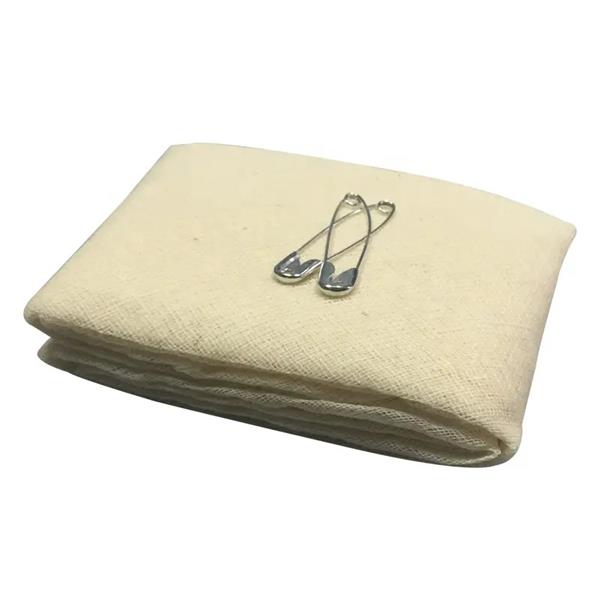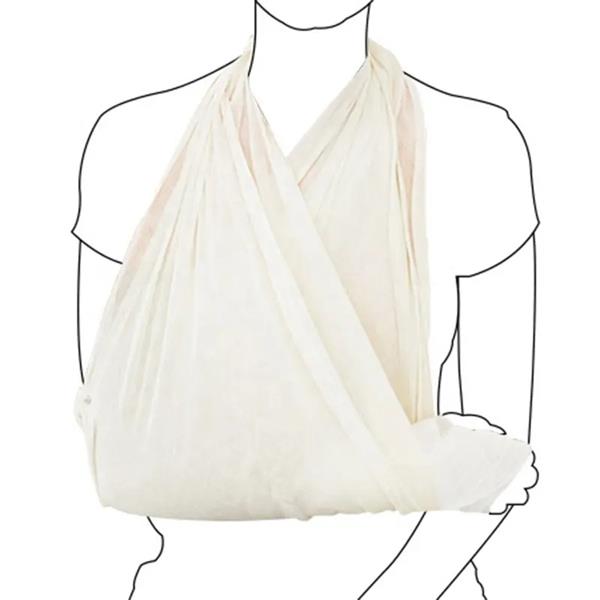In the world of medical supplies, the diversity of bandages is a crucial aspect of emergency care. From Crepe Bandages to PBT and High Elastic Bandages, each type serves a unique purpose in first aid. Understanding the roles these bandages play can make a significant difference in providing effective and timely medical assistance.
Crepe Bandage
Crepe Bandage, a staple in medical kits, is a stretchable and lightweight bandage known for its distinctive crepe or wrinkled texture. This unique texture allows the bandage to conform snugly to different body contours, ensuring effective compression and support.

One of the key features of Crepe Bandages is their elasticity. Made from a blend of cotton and elastic fibers, they provide a balance between flexibility and support. The bandage’s porous nature promotes air circulation, preventing the accumulation of moisture and ensuring comfort for the wearer. Additionally, the distinctive crepe weave enhances its gripping ability, securing the bandage in place during movement.
Applications:
Crepe Bandages find widespread use in various medical scenarios. Their primary application lies in providing support and compression for sprains, strains, and other injuries to muscles and joints. The bandage’s ability to adhere closely to the body makes it particularly effective in immobilizing injured limbs and reducing swelling. It is also utilized in the management of venous disorders and to secure dressings in place.

Advantages:
Versatility: Crepe Bandages adapt well to different body parts, making them versatile for various applications.
Elasticity: The stretchability of the bandage ensures a snug fit, providing optimal compression and support.
Breathability: Porous structure allows air circulation, preventing skin irritation and ensuring wearer comfort.
Cost-Effective: Crepe Bandages are economical and widely available, making them an accessible choice for both medical professionals and households.
Disadvantages:
Limited Reusability: Crepe Bandages may lose their elasticity over time, limiting their reuse.
Not Waterproof: The bandage’s porous nature means it is not suitable for use in wet conditions.
May Cause Allergies: Some individuals may be sensitive to the materials used, leading to skin irritation.
In essence, Crepe Bandages stand as a testament to versatility in the medical world, providing reliable support and compression in diverse first-aid situations. From sports injuries to everyday mishaps, the crepe bandage remains a valuable tool in the hands of caregivers and medical professionals alike.
PBT Bandage
PBT Bandage, short for Polyester, Viscose, and Elastic Bandage, is a resilient and versatile medical wrap renowned for its adaptability and effectiveness. This bandage combines polyester and viscose fibers with elastic threads, creating a durable and elastic fabric.

The unique blend of materials in PBT Bandages imparts them with notable qualities. Their high elasticity allows for easy application and a snug fit around different body parts. The fabric is also breathable, promoting air circulation and reducing the risk of skin irritation. PBT Bandages are known for their excellent conformability, ensuring optimal contact with the skin for effective compression.

Applications:
PBT Bandages find extensive applications in various medical scenarios. They are commonly used for providing support and compression in the treatment of sprains, strains, and other soft tissue injuries. The bandage’s ability to stretch and conform makes it suitable for securing dressings, immobilizing joints, and promoting the healing process. PBT Bandages are widely employed in hospitals, clinics, and first aid kits.

Advantages:
Adaptability: PBT Bandages conform easily to different body contours, ensuring a secure fit.
Breathability: The breathable fabric reduces the risk of skin irritation and promotes comfort.
Durable: The combination of polyester and viscose fibers makes PBT Bandages resilient and long-lasting.
Versatile Usage: Suitable for various medical applications, from wound dressing to joint immobilization.
Disadvantages:
May Require Clips or Tape: While some PBT Bandages come with self-adhesive properties, others may require additional clips or tape for secure fastening.
Cost: Compared to basic crepe bandages, PBT Bandages may be relatively more expensive.
In summary, PBT Bandages have emerged as a reliable and adaptive ally in the realm of medical care. Their versatility, combined with excellent conformability and durability, positions them as indispensable tools for healthcare professionals and individuals alike, offering effective support in diverse medical situations.
POP Bandage
POP Bandage, an abbreviation for Plaster of Paris Bandage, is a remarkable orthopedic casting material widely utilized for its unique molding properties. Comprising a fabric base impregnated with plaster of Paris, this bandage becomes rigid and durable when moistened, making it an ideal choice for creating customized casts.

The defining feature of POP Bandages is their ability to transform from a flexible state to a rigid structure when exposed to water. This characteristic allows healthcare professionals to mold the bandage directly onto the patient’s body, creating a customized and snug-fitting cast. Once dried, the cast provides robust support and immobilization to the injured or fractured area.

Applications:
POP Bandages are primarily employed in orthopedic care for the immobilization and stabilization of fractures, sprains, and other musculoskeletal injuries. Their molding capability enables healthcare practitioners to craft casts that precisely conform to the contours of the patient’s anatomy, promoting optimal healing. POP Bandages are commonly used in emergency departments, orthopedic clinics, and rehabilitation settings.

Advantages:
Customization: POP Bandages allow for the creation of tailored casts, ensuring a perfect fit for each patient.
Rigidity: Once set, the cast provides sturdy immobilization, aiding in the healing process.
Quick Setting: Plaster of Paris rapidly hardens when exposed to water, facilitating efficient application.
Versatility: Suitable for a wide range of orthopedic applications, from simple fractures to complex bone injuries.
Disadvantages:
Weight: POP casts can be relatively heavier compared to other bandage types, which may cause discomfort for some patients.
Not Water-Resistant: The cast can weaken if exposed to moisture, limiting its use in wet conditions.
In conclusion, POP Bandages stand as a molding marvel in the realm of orthopedic care, offering a unique combination of customization, rigidity, and versatility. As a crucial tool in fracture management, these bandages play a pivotal role in providing effective and personalized care to individuals with musculoskeletal injuries.
Triangular Bandage
A Triangular Bandage is a simple yet versatile piece of medical fabric shaped like a triangle, typically made from a soft and lightweight material. Despite its uncomplicated design, this bandage proves to be an indispensable tool in various first-aid situations due to its adaptability and ease of application.

The key characteristic of the Triangular Bandage is its triangular shape, which enables diverse applications. Usually made from cotton or similar materials, it is soft against the skin and can be easily folded or manipulated to suit different first aid needs. The bandage often comes with two long ends and a shorter base, allowing for secure and adjustable tying.

Applications:
Triangular Bandages are renowned for their versatility and are employed in a wide array of first-aid scenarios. Common uses include creating slings for arm or shoulder injuries, immobilizing fractures or dislocations, and providing additional support for bandages. Their adaptability makes them an essential component of any well-equipped first aid kit, catering to a range of injuries and emergencies.

Advantages:
Versatility: The triangular shape allows for a variety of applications, from slings to dressings.
Adjustability: The bandage can be easily manipulated and tied to provide secure and customized support.
Compact Design: Triangular Bandages are lightweight and fold into a compact size, making them convenient for storage and transportation.
Cost-Effective: They are an economical choice for first aid kits and emergencies.
Disadvantages:
Limited Compression: Triangular Bandages are not designed for compression, which may be a limitation in certain medical scenarios.
May Require Additional Fastening: Depending on the application, additional fastening or tying skills may be necessary.
In summary, the Triangular Bandage stands as a multifaceted essential in the realm of first aid, showcasing adaptability, simplicity, and cost-effectiveness. From makeshift slings to secure dressings, this unassuming piece of fabric proves to be a valuable asset in addressing a variety of injuries and emergencies.
High Elastic Bandage
A High Elastic Bandage, often referred to as a compression bandage, is a specialized medical wrap designed to provide consistent and controlled compression. Constructed from a blend of elastic and cotton fibers, this bandage is notable for its ability to stretch and conform to the body’s contours while maintaining resilience.

The defining feature of the High Elastic Bandage lies in its exceptional stretchability. The combination of elastic fibers with other materials results in a bandage that can be stretched to accommodate various body parts, ensuring a snug fit without compromising the level of compression. The bandage is typically lightweight, breathable, and can be easily applied without causing undue pressure.

Applications:
High-elastic bandages find extensive use in medical settings for compression therapy and support. They are commonly employed in the treatment of sprains, strains, edema, and venous disorders. The controlled compression provided by these bandages helps reduce swelling, promote blood circulation, and stabilize injured or weak joints. High-elastic bandages are prevalent in sports medicine, post-surgical care, and the management of chronic conditions.

Advantages:
Exceptional Stretch: High Elastic Bandages offer superior stretchability, ensuring optimal compression and support.
Versatility: Suitable for various applications, from joint stabilization to compression therapy for venous conditions.
Breathability: The bandage’s breathable nature prevents moisture buildup, enhancing wearer comfort.
Easy Application: Users can easily apply and adjust the bandage without professional assistance.
Disadvantages:
May Lose Elasticity Over Time: With repeated use, the elastic properties of the bandage may diminish.
Potential for Over-Compression: Incorrect application or excessive stretching can lead to over-compression, causing discomfort or circulation issues.
In summary, the High Elastic Bandage emerges as a vital tool in medical care, stretching the limits of support and compression. Its adaptability, combined with the ability to provide controlled pressure, positions it as an essential component in the management of various injuries and medical conditions, contributing to effective and targeted care for patients.
Gauze Bandage
A Gauze Bandage is a medical dressing made from loosely woven cotton fibers, providing a soft and breathable fabric. It is widely recognized for its absorbent nature and adaptability in wound care applications. Gauze bandages come in various forms, including rolls and pads, and are a fundamental component of medical kits and healthcare settings.

The defining characteristic of Gauze Bandages lies in their open-weave structure, allowing air to circulate freely. This design promotes optimal wound healing by maintaining a breathable environment. Gauze is highly absorbent, efficiently managing exudate from wounds. The bandage can be easily cut or shaped to fit different wound sizes, making it a versatile choice in various medical scenarios.

Applications:
Gauze Bandages find extensive use in wound care, offering a versatile solution for various injuries and surgical sites. They are commonly employed for dressing wounds, providing a protective layer against contaminants, and absorbing fluids. Gauze is often combined with antiseptic solutions for wound cleaning. Additionally, it serves as a primary layer for securing other dressings or as a component in creating compression bandages.

Advantages:
Breathability: The open-weave structure allows air circulation, promoting a conducive environment for wound healing.
Absorbency: Gauze is highly absorbent, effectively managing wound exudate.
Versatility: Easily adaptable to different wound sizes and shapes, making it suitable for various applications.
Cost-Effective: Gauze Bandages are generally affordable and widely available.
Disadvantages:
May Stick to Wounds: In certain cases, gauze may adhere to wounds, causing discomfort during removal.
Not Self-Adhesive: Additional securing methods may be required to keep the gauze in place.
In summary, the Gauze Bandage stands as a breathable and adaptable essential in the realm of wound care. Its absorbent nature, versatility, and cost-effectiveness make it a foundational tool in medical settings, ensuring effective management and protection of wounds in diverse scenarios.
Self-Adhesive Bandage/Cohesive Bandage
A Self-Adhesive or Cohesive Bandage is a type of bandage that adheres to itself without the need for clips or fasteners. Constructed from a blend of elastic and cohesive materials, this bandage is designed to provide secure compression and support while remaining easy to apply and remove.

The standout feature of Self-Adhesive Bandages is their cohesive nature, allowing them to stick to themselves without sticking to the skin or hair. The bandage is elastic, providing a comfortable and snug fit without impeding movement. It typically comes in various widths and lengths, catering to different application needs. Additionally, these bandages often come in a variety of colors.

Applications:
Self-adhesive bandages are widely used in a range of medical and non-medical scenarios. Their ease of application and ability to adhere securely make them popular in sports medicine, first aid kits, and veterinary care. These bandages are suitable for providing compression, supporting joints, and securing dressings. They are often chosen for their convenience in situations where quick and reliable wrapping is essential.

Advantages:
Easy Application: Self-adhesive bandages can be easily applied without the need for additional fasteners or tape.
Non-Stick: The bandage adheres to itself without sticking to the skin or causing discomfort during removal.
Versatile Usage: Suitable for a variety of applications, from wound dressing to joint support.
Customizable Fit: Available in different widths and lengths, allowing users to tailor the bandage to their specific needs.
Disadvantages:
Limited Reusability: Self-adhesive bandages may lose their adhesive properties with repeated use.
May Cause Allergies: Some individuals may be sensitive to the materials used, leading to skin irritation.
In summary, the Self-Adhesive or Cohesive Bandage stands as a go-to solution for those seeking quick and secure wrapping in various scenarios. Its ease of application, non-stick nature, and versatility make it a valuable addition to first aid kits and medical settings, providing efficient and reliable support when needed.







